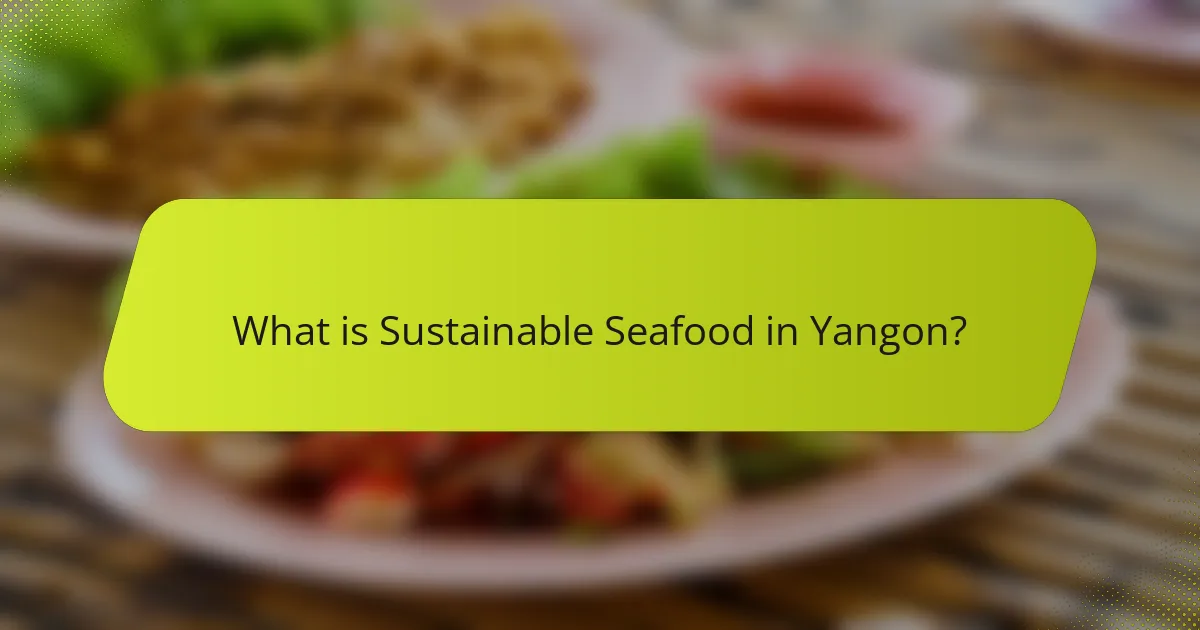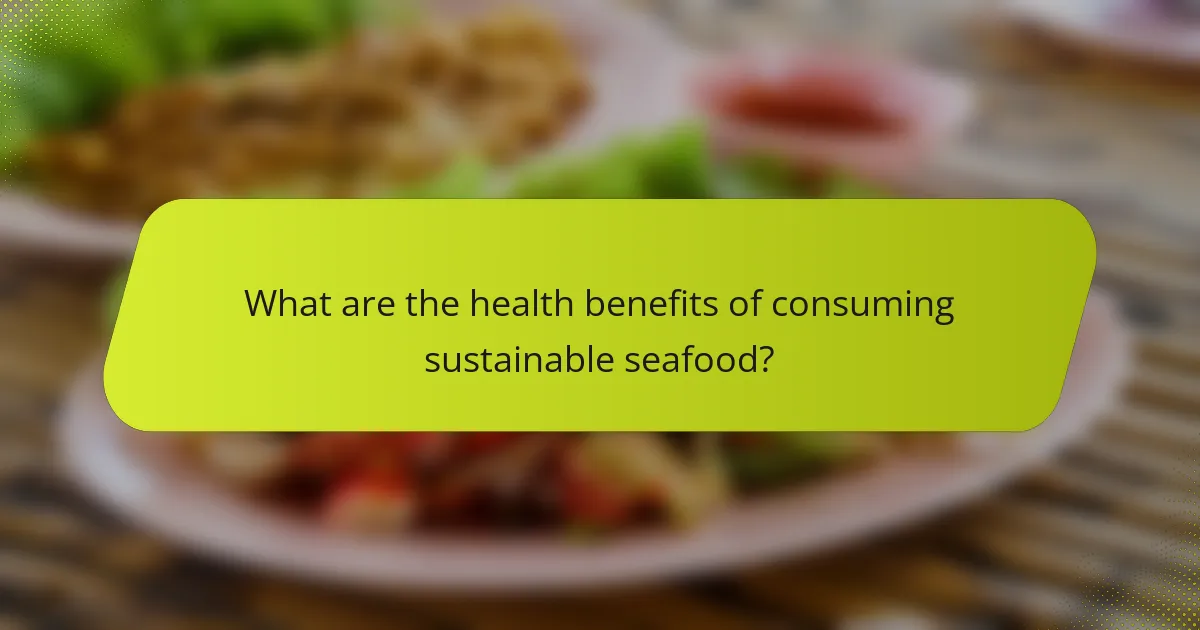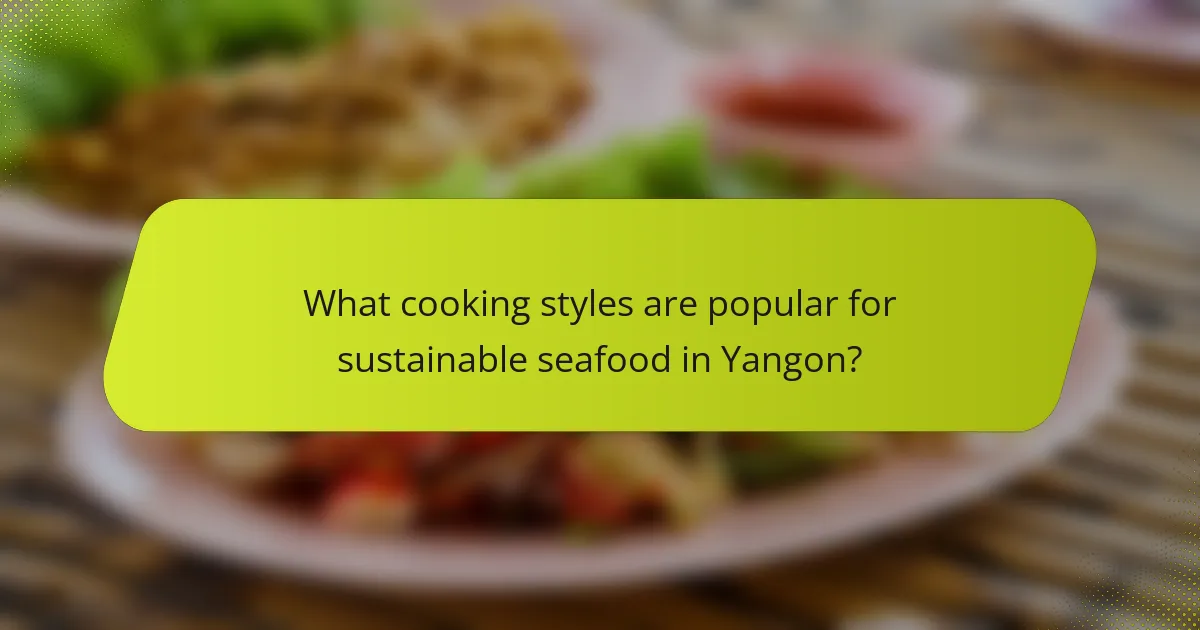Sustainable seafood in Yangon is seafood sourced responsibly to maintain fish populations and minimize environmental impact. This practice supports local fisheries and aquaculture methods that adhere to regulations aimed at preventing overfishing. The rising demand for sustainable seafood is driven by increased awareness of ocean health and the benefits of consuming seafood rich in protein, omega-3 fatty acids, and essential nutrients. Cooking methods such as grilling and steaming are popular in Yangon, preserving the natural flavors and nutrients of seafood while enhancing its appeal through local herbs and spices. This article explores the sourcing practices, health benefits, and cooking styles associated with sustainable seafood in Yangon.

What is Sustainable Seafood in Yangon?
Sustainable seafood in Yangon refers to seafood sourced in a manner that maintains fish populations and minimizes environmental impact. This practice ensures that the seafood is harvested responsibly, protecting marine ecosystems. In Yangon, sustainable seafood often comes from local fisheries that follow regulations to prevent overfishing. It also includes aquaculture practices that reduce harm to the environment. The demand for sustainable seafood has been rising due to increased awareness of ocean health. Various organizations in Myanmar promote sustainable fishing practices to support local communities. These initiatives help ensure the long-term viability of seafood resources in the region.
How is sustainable seafood defined in the context of Yangon?
Sustainable seafood in the context of Yangon is defined as seafood sourced in a way that maintains the health of fish populations and ecosystems. This involves practices that prevent overfishing and protect habitats. In Yangon, sustainable seafood often comes from local fisheries that adhere to responsible fishing methods. These methods include using nets that minimize bycatch and avoiding fishing during breeding seasons. The local government and NGOs promote awareness about sustainable practices among fishermen. Research indicates that sustainable seafood contributes to food security and economic stability in the region. By prioritizing sustainability, Yangon aims to ensure long-term availability of seafood for future generations.
What criteria determine sustainability in seafood sourcing?
Sustainability in seafood sourcing is determined by several key criteria. These include the health of fish populations, the impact on marine ecosystems, and the methods used for fishing. Healthy fish populations ensure that species can reproduce and thrive. The impact on marine ecosystems considers how fishing practices affect habitats and other marine life. Methods of fishing must minimize bycatch and habitat destruction. Additionally, sourcing practices should comply with regulations and certifications, such as those from the Marine Stewardship Council. These criteria collectively ensure that seafood sourcing is environmentally responsible and can be maintained over the long term.
Why is sustainability important for seafood in Yangon?
Sustainability is crucial for seafood in Yangon to ensure long-term availability and ecological balance. Overfishing has led to declining fish populations in the region. Sustainable practices help to replenish these stocks and maintain biodiversity. Additionally, sustainable seafood supports local economies by providing stable livelihoods for fishermen. The demand for responsibly sourced seafood is increasing among consumers, promoting better practices. Evidence shows that sustainable fisheries can yield higher profits over time compared to unsustainable methods. Protecting marine ecosystems also safeguards the health of communities reliant on seafood for nutrition. Thus, sustainability is essential for preserving resources and supporting the livelihoods of those in Yangon.
What are the sourcing practices for sustainable seafood in Yangon?
Sourcing practices for sustainable seafood in Yangon focus on responsible fishing methods. Fishermen are encouraged to use techniques that minimize bycatch and protect marine habitats. Local regulations promote the use of nets that reduce juvenile catch. Certification programs help consumers identify sustainably sourced seafood. Community-based management practices involve local stakeholders in decision-making. Education initiatives raise awareness about overfishing and its impacts. Collaborations with NGOs support sustainable fishing practices. These efforts aim to balance economic needs with environmental conservation.
How do local fishermen contribute to sustainable sourcing?
Local fishermen contribute to sustainable sourcing by employing traditional fishing methods. These methods often minimize environmental impact and preserve fish populations. They typically use nets and traps that reduce bycatch. Local fishermen also adhere to seasonal fishing practices. This ensures that fish species have time to reproduce. Furthermore, they often participate in community-based management systems. These systems promote responsible fishing practices and habitat conservation. Studies show that sustainable practices by local fishermen can enhance marine biodiversity. This contributes to the long-term viability of fisheries in their regions.
What regulations govern sustainable seafood sourcing in Yangon?
The regulations governing sustainable seafood sourcing in Yangon include the Myanmar Fisheries Law and various international agreements. The Myanmar Fisheries Law emphasizes the sustainable management of marine resources. It sets guidelines for fishing practices, species protection, and habitat conservation. Additionally, the government has committed to international agreements such as the FAO Code of Conduct for Responsible Fisheries. These regulations aim to ensure the long-term viability of fish stocks and protect marine ecosystems. Compliance with these laws is essential for promoting sustainable seafood practices in the region.
How does sustainable seafood impact the local economy?
Sustainable seafood positively impacts the local economy by creating jobs and supporting local fisheries. It fosters economic stability through responsible fishing practices. Local communities benefit from increased income as sustainable practices often lead to higher prices for quality seafood. Studies show that sustainable seafood markets can generate up to 20% more revenue compared to conventional fishing. Additionally, sustainable seafood initiatives promote tourism, attracting visitors interested in eco-friendly practices. This influx of tourists further stimulates local businesses and services. Overall, sustainable seafood contributes significantly to economic resilience in coastal areas.
What role do local markets play in promoting sustainable seafood?
Local markets play a crucial role in promoting sustainable seafood by connecting consumers directly with local fishers. This direct connection fosters transparency in sourcing practices. It encourages consumers to choose seafood that is caught sustainably. Local markets often prioritize selling species that are abundant and in season. This practice helps prevent overfishing of vulnerable species. Additionally, local markets support small-scale fisheries, which are typically more sustainable than large industrial operations. Research indicates that communities with strong local markets have better access to fresh, sustainable seafood options. In Yangon, these markets help educate consumers about the importance of sustainable choices.
How can consumers support sustainable seafood practices?
Consumers can support sustainable seafood practices by choosing seafood from certified sustainable sources. They should look for labels such as the Marine Stewardship Council (MSC) or the Aquaculture Stewardship Council (ASC). These certifications indicate that the seafood is sourced responsibly. Consumers can also reduce their seafood consumption to lessen demand on overfished species. Additionally, opting for local seafood reduces the carbon footprint associated with transportation. Engaging in community-supported fisheries (CSFs) helps support local fishermen who practice sustainable methods. Educating themselves about seafood species and their sustainability status can guide informed purchasing decisions. Supporting restaurants that prioritize sustainable seafood contributes to broader industry change.

What are the health benefits of consuming sustainable seafood?
Consuming sustainable seafood offers numerous health benefits. It is a rich source of high-quality protein, essential omega-3 fatty acids, and vital vitamins and minerals. Omega-3 fatty acids support heart health and reduce inflammation. Sustainable seafood is often lower in contaminants compared to overfished species. This ensures safer consumption for individuals, especially vulnerable populations like pregnant women and children. Studies show that diets rich in seafood can lower the risk of chronic diseases. The Marine Stewardship Council states that sustainable seafood practices help maintain fish populations and ecosystems, promoting long-term health benefits for consumers.
How does sustainable seafood compare to conventional seafood in terms of health?
Sustainable seafood generally offers better health benefits compared to conventional seafood. Sustainable seafood is sourced from fisheries that maintain ecological balance and avoid overfishing. This approach often results in lower levels of contaminants such as mercury and PCBs. Studies indicate that sustainable seafood can be richer in omega-3 fatty acids. These fatty acids are linked to improved heart health and cognitive function. Moreover, sustainable practices often prioritize feeding fish a natural diet, enhancing nutritional quality. In contrast, conventional seafood may come from farms that use antibiotics and artificial feed, which can compromise health benefits. Research from the Marine Stewardship Council shows that sustainable seafood supports healthier ecosystems, which in turn benefits human health.
What nutrients are abundant in sustainable seafood?
Sustainable seafood is rich in essential nutrients. Key nutrients include omega-3 fatty acids, which support heart health. It also contains high-quality protein, necessary for muscle growth and repair. Vitamins such as B12 are abundant, crucial for nerve function and energy production. Minerals like selenium and iodine are present, important for thyroid function and antioxidant protection. Sustainable seafood often has lower levels of harmful contaminants compared to non-sustainable options, enhancing its nutritional profile. Studies show that regular consumption of sustainable seafood contributes to overall health benefits.
How can sustainable seafood contribute to a balanced diet?
Sustainable seafood can significantly contribute to a balanced diet by providing essential nutrients. It is rich in high-quality protein, which is vital for muscle growth and repair. Sustainable seafood sources, such as fish and shellfish, are also high in omega-3 fatty acids. Omega-3s are known to support heart health and brain function. Additionally, seafood is a good source of vitamins and minerals, including vitamin D, B vitamins, and selenium. These nutrients play important roles in overall health and well-being. Research indicates that incorporating seafood into a diet can reduce the risk of chronic diseases. For example, the American Heart Association recommends eating fish at least twice a week for cardiovascular health. Sustainable seafood also promotes environmentally friendly practices, ensuring that future generations have access to these nutritional benefits.
What are the potential risks associated with non-sustainable seafood?
Non-sustainable seafood poses significant risks to marine ecosystems and human health. Overfishing leads to the depletion of fish populations, disrupting food chains. This can cause ecological imbalances, affecting species diversity. Furthermore, non-sustainable fishing practices often result in bycatch, harming unintended marine life. The use of harmful chemicals in aquaculture can contaminate water sources and seafood. Consuming non-sustainable seafood may expose humans to higher levels of toxins, such as mercury. Reports indicate that certain fish species are now critically endangered due to unsustainable practices. These risks underscore the importance of sourcing seafood sustainably.
How do contaminants affect health in non-sustainable seafood?
Contaminants in non-sustainable seafood can negatively impact human health. These contaminants often include heavy metals, pesticides, and polychlorinated biphenyls (PCBs). Consuming seafood contaminated with heavy metals like mercury can lead to neurological and developmental issues. Pesticides found in non-sustainable seafood can disrupt endocrine function and cause reproductive problems. PCBs are linked to immune system suppression and increased cancer risk. A study by the World Health Organization indicates that long-term exposure to these contaminants can lead to serious health issues. Therefore, the consumption of non-sustainable seafood poses significant health risks due to these harmful contaminants.
What are the long-term health implications of consuming non-sustainable seafood?
Consuming non-sustainable seafood can lead to long-term health implications. These seafood sources often contain higher levels of toxins, such as mercury and PCBs. Over time, these toxins can accumulate in the human body. This accumulation can result in neurological damage and cognitive deficits. Additionally, non-sustainable fishing practices can deplete fish populations, affecting food security. Research indicates that seafood from overfished stocks is often less nutritious. A study by the Food and Agriculture Organization (FAO) highlights the risks of consuming fish with high contaminant levels. Ultimately, these factors can contribute to chronic health issues over time.

What cooking styles are popular for sustainable seafood in Yangon?
Grilling and steaming are popular cooking styles for sustainable seafood in Yangon. These methods preserve the natural flavors and nutrients of the seafood. Grilling adds a smoky taste while allowing excess fat to drip away. Steaming maintains moisture and tenderness without the need for added oils. Both styles emphasize freshness, a key aspect of sustainable seafood. Local markets often provide fresh catches, enhancing the appeal of these cooking methods. Traditional recipes frequently incorporate local herbs and spices, enhancing the overall flavor profile.
How can sustainable seafood be prepared to enhance its flavors?
Sustainable seafood can be prepared to enhance its flavors through various cooking methods. Grilling brings out a smoky flavor while retaining moisture. Steaming preserves delicate textures and natural tastes. Searing creates a crust that locks in juices and adds depth. Marinating with herbs and citrus brightens the seafood’s profile. Using fresh, local ingredients amplifies the overall flavor. Cooking at the right temperature ensures optimal taste and texture. Each method highlights the seafood’s natural qualities, making it more enjoyable.
What traditional cooking methods are used in Yangon?
Traditional cooking methods used in Yangon include steaming, boiling, and grilling. Steaming is common for preparing seafood dishes, preserving flavor and nutrients. Boiling is often used for soups and broths, showcasing local ingredients. Grilling is popular for street food, enhancing the taste with smoky flavors. These methods reflect the region’s culinary heritage and emphasize fresh, sustainable ingredients. Historical practices in Yangon highlight a strong connection to local fishing communities and their sustainable sourcing techniques.
How do modern cooking techniques influence sustainable seafood dishes?
Modern cooking techniques enhance sustainable seafood dishes by promoting healthier preparation methods. Techniques such as sous-vide and steaming preserve nutrients and flavors. These methods reduce the need for excessive fats and oils, aligning with health-conscious dining trends. Additionally, modern techniques often emphasize local and seasonal ingredients. This supports sustainable sourcing practices by minimizing transportation impacts. Studies show that cooking methods like grilling and poaching also reduce waste by utilizing the entire fish. Furthermore, innovative techniques can create unique flavor profiles, attracting more consumers to sustainable options. Overall, modern cooking techniques significantly contribute to the sustainability and appeal of seafood dishes.
What are some popular sustainable seafood dishes in Yangon?
Some popular sustainable seafood dishes in Yangon include Mohinga, a fish soup with rice noodles. Another dish is Ngapi Yay, a shrimp paste dip served with vegetables. Grilled fish, often sourced from local fisheries, is also common. These dishes emphasize local ingredients and responsible sourcing practices. The use of seasonal fish helps support sustainable fishing efforts in the region. Additionally, many restaurants promote eco-friendly seafood options to protect marine ecosystems.
What ingredients are commonly paired with sustainable seafood?
Common ingredients paired with sustainable seafood include fresh herbs, citrus fruits, and vegetables. Fresh herbs such as parsley, cilantro, and dill enhance flavor. Citrus fruits like lemon and lime add acidity and brightness. Vegetables such as asparagus, bell peppers, and zucchini provide texture and nutrition. These pairings complement the natural taste of seafood. They also promote a balanced meal. Using seasonal and local produce is encouraged for sustainability. This approach supports local economies and reduces environmental impact.
How do cultural influences shape sustainable seafood recipes?
Cultural influences shape sustainable seafood recipes by dictating ingredient choices, cooking methods, and presentation styles. Different cultures have unique preferences for seafood types based on local availability. For instance, coastal communities often utilize fish that are abundant in their waters. Traditional cooking methods, such as steaming or grilling, reflect cultural practices that emphasize health and sustainability. Additionally, cultural beliefs about nutrition can affect which seafood is considered desirable. Festivals and rituals may highlight specific seafood dishes, further embedding them into the culinary landscape. Research indicates that communities with strong cultural ties to fishing often prioritize sustainable practices to preserve their heritage and resources. This interconnectedness of culture and sustainability leads to diverse and responsible seafood recipes.
What tips can help home cooks prepare sustainable seafood effectively?
Home cooks can prepare sustainable seafood effectively by sourcing from reputable suppliers. Choose seafood certified by organizations like the Marine Stewardship Council. Look for local options to reduce carbon footprint. Understand seasonal availability to select the freshest options. Use appropriate cooking methods, such as steaming or grilling, to preserve nutrients. Avoid overcooking to maintain texture and flavor. Incorporate sustainable seafood into a variety of dishes for balanced meals. Educate yourself on the species to avoid those that are overfished. These practices not only support sustainability but also enhance culinary experiences.
Sustainable seafood in Yangon is defined as seafood sourced responsibly to maintain fish populations and minimize environmental impact. The article explores the criteria for sustainability in seafood sourcing, emphasizing the importance of local fisheries and aquaculture practices that protect marine ecosystems. It highlights the health benefits of consuming sustainable seafood, compares it to conventional options, and discusses popular cooking styles and dishes in Yangon. Additionally, the article addresses the role of local markets and consumer choices in promoting sustainable practices, ensuring economic stability, and supporting community livelihoods.
